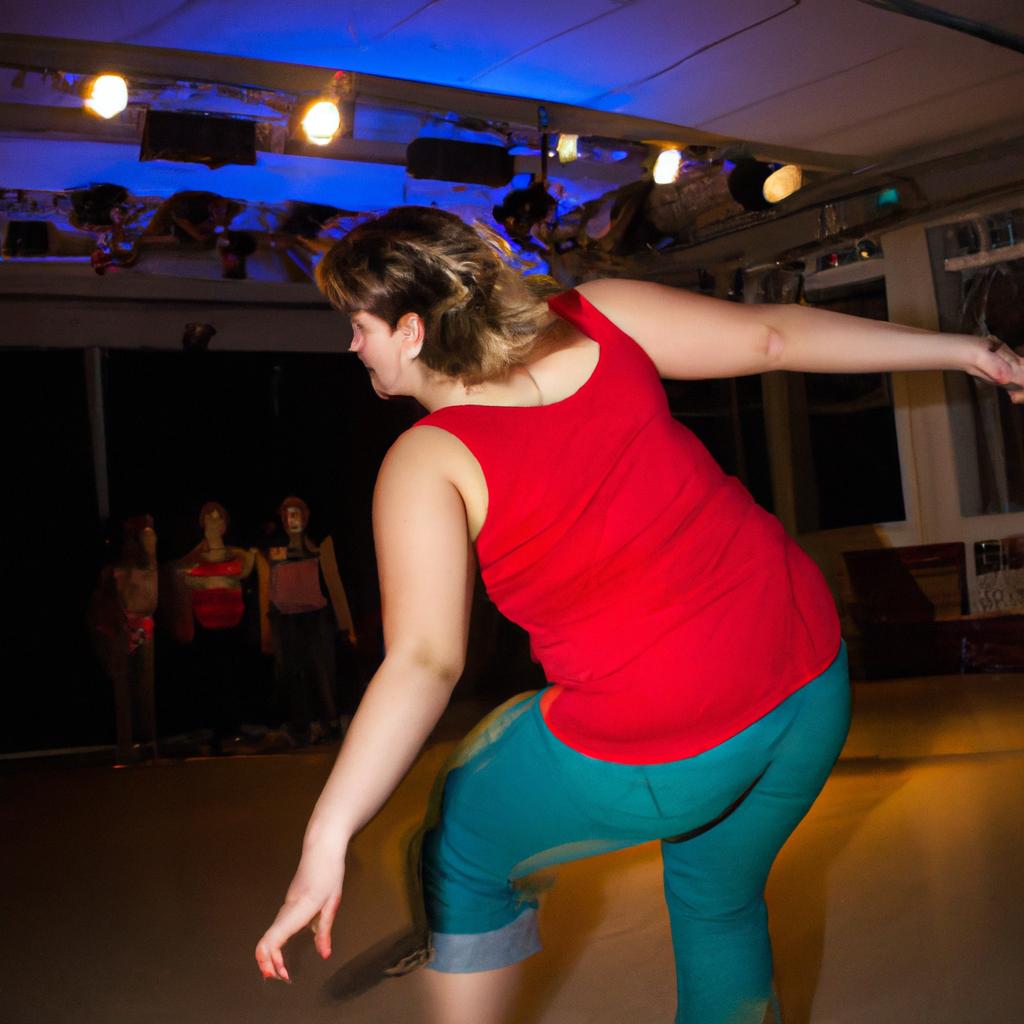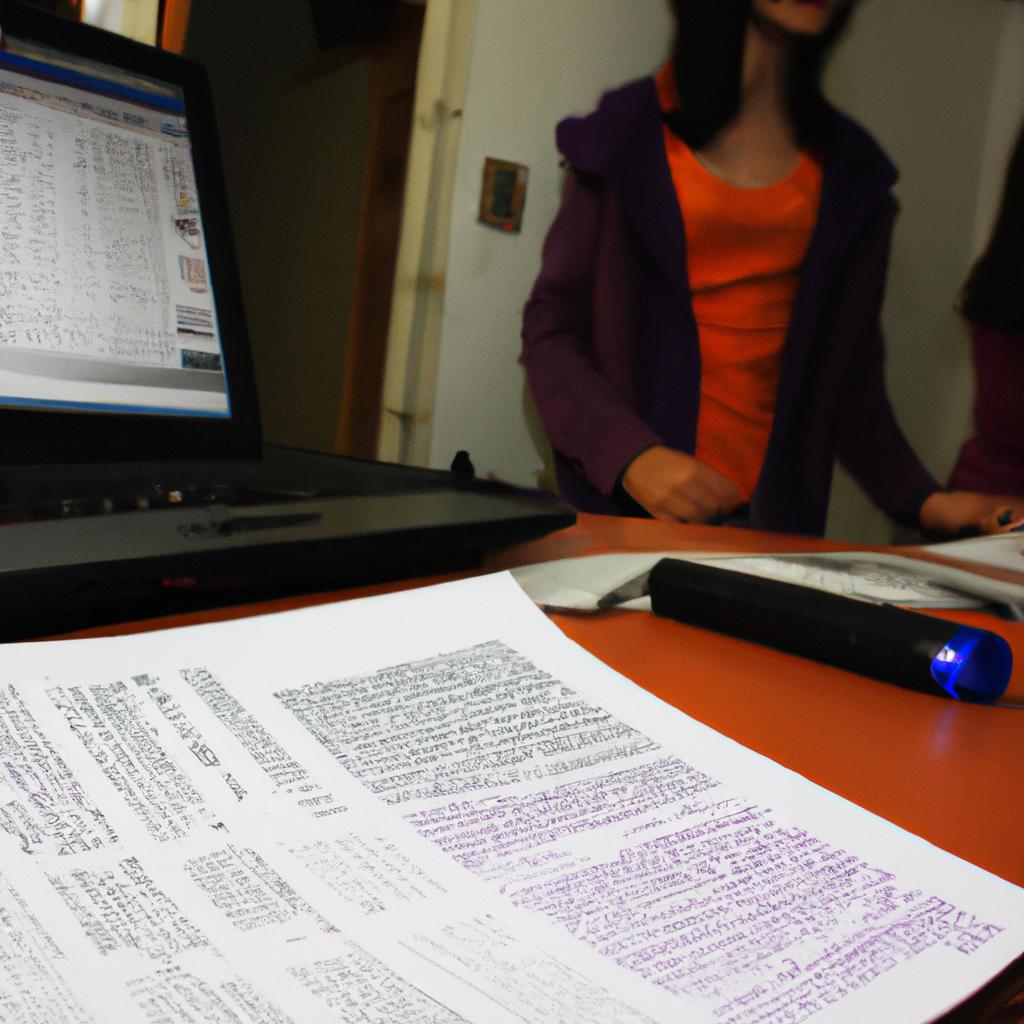The Art of Improvisation: Theatrical Techniques for Actresses: A Comprehensive Guide.

The ability to improvise is a valuable skill for actresses, allowing them to think on their feet and create authentic performances. This comprehensive guide explores the art of improvisation in theater, focusing specifically on techniques tailored for actresses. Through the analysis of various case studies and hypothetical scenarios, this article aims to provide an academic understanding of how improvisational skills can enhance an actress’s craft.
Imagine a scenario where an actress forgets her lines during a live performance. In such instances, the technique of improvisation becomes crucial as it allows her to seamlessly continue the scene without breaking character or disrupting the flow of the play. By mastering the art of improvisation, actresses gain not only confidence but also versatility in their performances. They are able to adapt quickly to unexpected situations, adding depth and spontaneity to their characters.
This article delves into different theatrical techniques that aid in honing improvisational skills for actresses. From developing strong listening and observational abilities to practicing active responsiveness with fellow actors, these techniques enable performers to stay present in the moment while embodying their characters fully. Additionally, this guide will explore methods for building trust within an ensemble cast and fostering a collaborative environment that encourages spontaneous creativity. With its focus on empowering actresses through practical strategies and theoretical insights, this guide is an invaluable resource for any actress looking to enhance her improvisational skills and elevate her performances to new heights.
Understanding the Basics of Improvisation
Improvisation is a fundamental skill for actresses that allows them to think on their feet, react in the moment, and bring authenticity to their performances. In this section, we will explore the basics of improvisation and its significance in theatrical techniques.
To illustrate the importance of improvisation, let’s consider a hypothetical scenario: imagine an actress performing on stage when suddenly a prop she was supposed to use breaks. Without missing a beat, she seamlessly incorporates the broken prop into her scene, turning it into a comedic moment that delights the audience. This example demonstrates how improvisation can enhance a performance by embracing unexpected situations and transforming them into opportunities rather than obstacles.
To fully comprehend the essence of improvisation, it is crucial to understand its core principles:
- Spontaneity: An essential aspect of improv is being present in the moment without preconceived ideas or plans.
- Active listening: Actresses must actively listen to their fellow performers and respond authentically to what they hear.
- Collaboration: Successful improvisation relies heavily on collaboration with other actors as each participant builds upon one another’s ideas.
- Risk-taking: Embracing risk is necessary for pushing boundaries and exploring new possibilities within scenes.
The following table further illustrates these principles:
| Principle | Description | Example |
|---|---|---|
| Spontaneity | Reacting naturally without prior preparation | Responding immediately to unexpected dialogue |
| Active Listening | Paying close attention to others’ cues | Adjusting responses based on changes in tone or body language |
| Collaboration | Working together with fellow actors | Building upon each other’s ideas during improvised scenes |
| Risk-taking | Taking chances and trying something new | Introducing unpredictable elements into a scene |
By understanding these basic principles, actresses can cultivate a strong foundation for successful improvisation. In the subsequent section, we will explore techniques for developing spontaneity and creativity in order to further enhance improvisational skills.
Transitioning into the next section about “Developing Spontaneity and Creativity,” actresses can continue refining their improvisation abilities by exploring various exercises and strategies. By building upon a solid understanding of the basics, they can unlock new dimensions of their performances and unleash their creative potential on stage.
Developing Spontaneity and Creativity
Having gained a solid understanding of the basics of improvisation, we can now delve into techniques that focus on developing spontaneity and creativity. By building upon the foundation established in understanding the improvisational process, actors can further hone their skills to create compelling performances that captivate audiences. In this section, we will explore various strategies and exercises designed to foster creative thinking and encourage actors to embrace spontaneity within their craft.
Developing Spontaneity through Exercises:
To cultivate spontaneity, it is essential for actresses to engage in specific exercises that push them out of their comfort zones. One effective exercise involves pairing up performers who must initiate a scene without any prior discussion or planning. This encourages spontaneous reactions as each actress responds instinctively to her partner’s choices, creating an authentic interaction between characters. For example, imagine two actresses starting a scene where one unexpectedly presents the other with a bouquet of flowers while sitting on a park bench; observing how they respond spontaneously enables organic character development.
Fostering Creativity through Techniques:
In addition to cultivating spontaneity, enhancing creativity is vital for actresses seeking to bring depth and originality to their performances. To stimulate imaginative thinking, consider utilizing the following techniques:
- Stream-of-Consciousness Writing: Encourage actresses to write freely and rapidly about a given topic without inhibition or self-censorship. This allows unique ideas and associations to flow uninhibitedly onto paper.
- Object Transformation Exercise: Prompt actresses to select an object unrelated to their character or scene and then transform it mentally into something relevant. This technique challenges conventional thinking by encouraging unexpected connections.
- Role Reversal: Ask actresses to switch roles with another actor during rehearsals or workshops. By portraying different characters than originally assigned, they gain new perspectives and generate fresh insights into their own roles.
- Visual Collage Creation: Have actresses create collages that represent their characters’ emotions, experiences, or aspirations. This visual exercise encourages exploration of the character’s inner world and can inspire inventive choices during improvisation.
Emotional Responses Evoked:
Consider how these exercises and techniques foster spontaneity and creativity within a theatrical setting:
- Increased Confidence: Actresses gain confidence in trusting their instincts and making bold choices.
- Authentic Connection: The spontaneous nature of improvisation enables genuine connections to form between actors, resonating with audiences.
- Unexpected Brilliance: By pushing boundaries and embracing creative thinking, performances become unpredictable and captivating.
- Emotional Resonance: Through exploring diverse perspectives and tapping into personal experiences, actresses evoke complex emotions in both themselves and viewers.
| Exercise | Technique | Purpose |
|---|---|---|
| Stream-of-Consciousness | Encourages free-flowing ideas | Uninhibited expression |
| Object Transformation | Sparks unconventional associations | Expands creative thinking |
| Role Reversal | Shifts perspective | Generates fresh insights |
| Visual Collage Creation | Inspires imaginative choices | Deepens understanding of character’s inner world |
Through developing spontaneity and fostering creativity, actresses lay the groundwork for embodying richly layered characters. By exploring various characterization techniques, they delve deeper into their roles, adding complexity and nuance to their performances. Let us now embark on this journey as we uncover the artistry behind bringing fictional personas to life on stage.
Note: Please use appropriate markdown syntax when incorporating bullet points or tables into your document.
Exploring Characterization Techniques
Building upon the foundation of developing spontaneity and creativity, this section delves into exploring characterization techniques. By understanding how to effectively portray different characters on stage, actresses can enhance their improvisational skills and deliver compelling performances.
Paragraph 1:
To illustrate the importance of effective characterization, let’s consider a hypothetical scenario involving an actress named Emma. Emma is tasked with portraying two contrasting characters in consecutive scenes – one being a timid introvert and the other an arrogant socialite. Through her exploration of various characterization techniques, such as physicality, vocal modulation, and emotional embodiment, Emma successfully brings these distinct personas to life. This showcases the power of character development in creating believable performances that captivate audiences.
- Immersion in character motivations
- Experimentation with body language
- Utilization of voice modulation
- Emotional connection to character traits
| Characterization Techniques | Description |
|---|---|
| Immersion in character motivations | Understanding a character’s desires, fears, and objectives allows for more authentic portrayal. |
| Experimentation with body language | Exploring different gestures, postures, and movements helps bring out unique characteristics. |
| Utilization of voice modulation | Altering tone, pitch, pace, or accent aids in distinguishing between diverse personalities. |
| Emotional connection to character traits | Connecting emotionally with specific attributes amplifies believability and relatability. |
Paragraph 2:
Incorporating these techniques not only enhances an actress’s ability to improvise but also deepens the overall theatrical experience for both performers and spectators alike. The utilization of immersive characterizations has the potential to evoke powerful emotions within viewers by allowing them to connect intimately with the story unfolding before them. Additionally, employing varied physicality and vocal expression creates dynamic interactions among actors on stage, further enriching the dramatic atmosphere.
With a solid understanding of effective characterization techniques, actresses can now move on to mastering scene work and dialogue. By honing these skills, they will be better equipped to engage with their fellow performers and create compelling narratives that resonate with audiences.
Mastering Scene Work and Dialogue
In the previous section, we delved into various techniques used to explore and develop characters in theatrical performances. Now, let us shift our focus towards mastering scene work and dialogue, essential aspects that bring these characters to life on stage.
To illustrate the importance of effective scene work, consider a hypothetical scenario where an actress is portraying a character who has just received devastating news about a loved one’s passing. The actress must convey the raw emotions of grief and despair while engaging with her scene partner in a believable and compelling manner.
To achieve this level of authenticity, actresses can employ several key strategies:
-
Active Listening: Actresses should actively listen to their peers during scenes, paying close attention not only to spoken words but also non-verbal cues such as body language and facial expressions. This attentiveness allows for genuine reactions and responses, enhancing the overall realism of the performance.
-
Emotional Availability: It is crucial for actresses to tap into their own emotional reservoirs when approaching intense or emotionally charged scenes. By being emotionally available and open-minded, they can access authentic feelings that resonate with both themselves and the audience.
-
Physicality and Spatial Awareness: Effective use of physicality helps create dynamic interactions between characters on stage. Understanding spatial relationships within a scene enables actresses to navigate shared spaces convincingly, adding depth to their performances.
-
Timing and Pace: Mastering timing and pace is vital in conveying the rhythm of dialogue within a scene. By understanding the nuances of comedic timing or dramatic pauses, actresses can heighten tension or inject humor effectively.
Embracing these strategies enhances an actress’s ability to fully immerse herself in her role while working collaboratively with fellow actors. In turn, this fosters trust among scene partners, leading to more harmonious collaborations on stage.
Transitioning into our next section about “Building Trust and Collaboration with Scene Partners,” we will further explore how establishing a strong foundation of trust contributes to creating memorable performances.
Building Trust and Collaboration with Scene Partners
In the previous section, we explored the mastery of scene work and dialogue as crucial elements for actresses to excel in their craft. Now, let us delve into another vital aspect that can greatly enhance performances on stage or screen – the importance of physicality in scene work. To illustrate this point, consider a hypothetical case study involving an actress named Sarah.
Sarah is cast as a character who is experiencing deep grief after losing a loved one. Through her understanding of physicality techniques, she explores how different body postures, movements, and gestures can convey the intensity of her character’s emotions. By slumping her shoulders, lowering her head, and adopting slow and deliberate movements during rehearsal, Sarah effectively conveys her character’s state of mourning. This attention to physicality not only enhances the believability of her performance but also allows the audience to empathize with her character’s pain.
To further highlight the significance of incorporating physicality in scene work, here are some key aspects to consider:
- Body language: Utilizing specific gestures and facial expressions can communicate emotions more authentically than words alone.
- Spatial awareness: Understanding how movement within a given space can affect relationships between characters and create dynamic stage pictures.
- Energy levels: Adjusting energy levels through posture and movement helps establish mood and intention within a scene.
- Non-verbal communication: Paying attention to subtle cues such as eye contact or proximity can add depth to interactions between characters.
By integrating these principles into their performances, actresses can elevate their portrayals beyond mere recitations of lines. Employing effective physicality techniques enables them to connect with audiences on an emotional level while bringing their characters vividly to life.
Transitioning seamlessly from our discussion on physicality in scene work brings us to our next section – improving listening and reacting skills. In this segment, we will explore strategies that allow actresses to better engage with their scene partners, fostering organic and authentic interactions on stage or screen.
Improving Listening and Reacting Skills
Having established the importance of building trust and collaboration in improvisational theater, we now turn our focus to refining listening and reacting skills. This next section explores techniques that enable actresses to strengthen their ability to respond authentically and spontaneously within a scene.
Improving Listening Skills:
Listening is an essential skill for effective improvisation as it allows actresses to fully engage with their scene partners. By actively listening, performers can pick up on subtle cues and nuances, enhancing their ability to react naturally. For instance, imagine a hypothetical scenario where two actresses are performing a scene together. Actress A notices that her scene partner, Actress B, starts speaking more softly and exhibiting closed body language. Through active listening, Actress A recognizes these signals as signs of vulnerability or discomfort. She adjusts her own approach accordingly by offering support and creating a safe space for Actress B to express herself freely.
To improve listening skills further, consider the following strategies:
- Maintain eye contact with your scene partner.
- Avoid interrupting or finishing sentences prematurely.
- Focus on understanding rather than formulating responses immediately.
- Practice reflective listening by paraphrasing what you have heard before responding.
Reacting Authentically:
Reacting genuinely within improvised scenes adds depth and believability to performances. Actresses should strive to avoid preconceived notions or predetermined reactions; instead, they must allow themselves to be truly present in each moment. To illustrate this point, let’s consider another example: during an improvised argument between two characters, one actress unexpectedly bursts into tears due to emotional triggers from her personal life. Rather than dismissing or ignoring this unexpected reaction, the other actress embraces empathy and responds compassionately within the context of the scene.
Here are some techniques for improving authentic reactions:
- Embrace vulnerability: Allow yourself to be emotionally open during scenes.
- Stay connected: Continuously monitor your emotional state while remaining connected with your character and scene partner.
- Trust your instincts: React spontaneously without overthinking or analyzing every action.
- Be present in the moment: Focus on what is happening now, rather than worrying about future outcomes.
| Techniques for Improving Listening Skills | Techniques for Reacting Authentically |
|---|---|
| Maintain eye contact | Embrace vulnerability |
| Avoid interrupting | Stay connected |
| Focus on understanding | Trust your instincts |
| Practice reflective listening | Be present in the moment |
In conclusion, refining listening and reacting skills is crucial for actresses seeking to excel in improvisational theater. By actively engaging with their scene partners through careful listening and authentic reactions, performers can create compelling and believable moments onstage. Through practice and dedication, actresses can cultivate these essential skills and elevate their performances to new heights.






